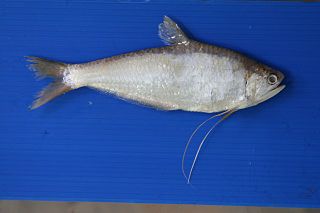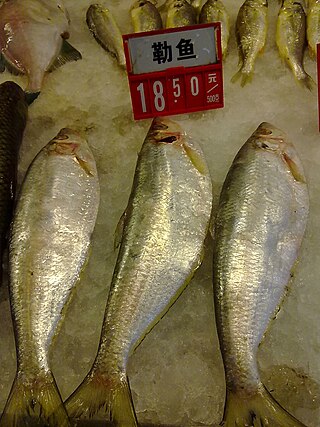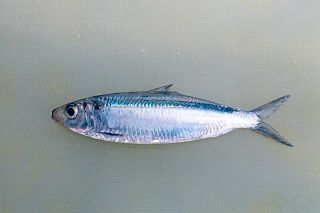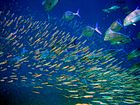
Herring are various species of forage fish, belonging to the order Clupeiformes.

Pristigasteridae is a family of ray-finned fish related to the herrings, including the genera Ilisha, Pellona, and Pristigaster. One common name for the taxon is longfin herring. The taxonomic classification of this family is in doubt; it was traditionally divided into two subfamilies, Pelloninae and Pristigasterinae, but molecular data indicates that these are not monophyletic.
The Argentine anchoita or Argentine anchovy is an anchovy of the genus Engraulis, found in and around waters of Argentina, Uruguay and southern Brazil.

Sardinella is a genus of fish in the family Dorosomatidae found in the Atlantic, Indian and Pacific Ocean. They are abundant in warmer waters of the tropical and subtropical oceans. Adults are generally coastal, schooling, marine fish but juveniles are often found in lagoons and estuaries. These species are distinguished by their ranges and by specific body features, but they are often confused with one another. Fish of the genus have seven to 14 striped markings along the scales of the top of the head. The paddle-shaped supramaxilla bones are characteristic; they separate Sardinella from other genera and their shapes help distinguish species. They have paired predorsal scales and enlarged fin rays.

Tenualosa is a genus of ray-finned fish belonging to the family Dorosomatidae, which also includes the gizzard shads and sardinellas. These fishes are found in rivers, brackish waters and coasts in the Indo-Pacific region.

Thryssa is a genus of anchovies in the family Engraulidae. Some authorities include the species from the genus Thrissina here.

Polydactylus is a genus of threadfin that mainly are native to the Indian, Atlantic and Pacific Oceans, especially in coastal or brackish waters. Some may even enter rivers and a single, P. macrophthalmus, is a freshwater fish from rivers in Borneo.

Escualosa is a genus of fishes in the herring family, Dorosomatidae. The genus currently contains two described species. They are found in Indo-Pacific.

Setipinna, the hairfin anchovies, is a genus of anchovies. These fish derive their name from the long, filamentous extension of the pectoral fins that is found in most species. It currently contains eight recognized species.

Herklotsichthys is a genus of herrings in the family Dorosomatidae found mostly around Southeast Asia and Australia with one species each in the Persian Gulf, the Red Sea, and the western Indian Ocean. This genus currently contains 12 species.
The Araucanian herring is a species of fish in the family Clupeidae. It is an epipelagic fish, silvery below and dark blue above, which schools in coastal waters off the west coast of South America. It ranges along the Chilean coast from Valparaiso south to Talcahuano. It schools at depths from 0 to 70 meters in nearshore areas.

The elongate ilisha, also known as the Chinese herring or slender shad, is a species of longfin herring native to the coastal waters and estuaries of North Indian Ocean and Northwest Pacific. It is a relatively large species, up to 45–60 centimetres (18–24 in) in total length. It is an important fishery species.

Amblygaster leiogaster, the smoothbelly sardinella, also known as blue sardine, blue sprat, bluebait, is a reef-associated marine species of sardinella in the herring family Clupeidae. It is one of the three species of genus Amblygaster. It is found in the marine waters along Indo-West Pacific regions south towards western Australia. The fish has 13 to 21 dorsal soft rays and 12 to 23 anal soft rays. It grows up to a maximum length of 23 cm. The flank is gold in fresh fish but becomes black while preservation. Belly is more rounded and scutes are not prominent. It is rather closely resemble Amblygaster clupeoides, but the latter has very few lower gill rakers than smoothbelly sardinella. The fish feeds on minute organisms like zooplankton.
Thryssa dayi, also known as Day's thryssa, is a species of ray-finned fish in the family Engraulidae. It is found in the western Indian Ocean.
Thryssa rastrosa, the Fly River thryssa, is a species of ray-finned fish in the family Engraulidae. It is found in Oceania.
Thryssa kammalensoides, the Godavari thryssa, is a species of ray-finned fish in the family Engraulidae. It is found in the western Indian Ocean.

Cetengraulis edentulus, the Atlantic anchoveta, is a species of ray-finned fish in the family Engraulidae. It is found in the western Atlantic Ocean.
Stolephorus advenus, the false Indian anchovy, is a species of ray-finned fish in the family Engraulidae. It is found in the western-central Pacific Ocean.
Stolephorus dubiosus, the Thai anchovy, is a species of ray-finned fish in the family Engraulidae. It is found in the western-central Pacific Ocean.
Tenualosa macrura, also known as the longtail shad, is a species of fish in the family Dorosomatidae.













